Personality and Phobias in Adolescence: Age and Gender in Psychopathological Expressions
Highlights
- Age, gender and personality attitudes are relevant factors to consider in the expression of adolescent psychopathological phenomena.
- Higher presence of anxiety, eating disorders and phobias emerged in female individuals, decreasing with age.
- Phobic expressions could be underestimated in adolescent individuals, such as their relation with personality.
Highlights
- Age, gender and personality attitudes are relevant factors to consider in the expression of adolescent psychopathological phenomena.
- Higher presence of anxiety, eating disorders and phobias emerged in female individuals, decreasing with age.
- Phobic expressions could be underestimated in adolescent individuals, such as their relation with personality.
Abstract
Introduction
Materials and Methods
Results
Discussions
Conclusions
Conflict of interest disclosure
Compliance with ethical standards
References
- Benjet, C.; Borges, G.; Stein, D.J.; Méndez, E.; Medina-Mora, M.E. Epidemiology of fears and specific phobia in adolescence: results from the Mexican Adolescent Mental Health Survey. J Clin Psychiatry. 2012, 73, 152–158. [Google Scholar] [CrossRef]
- Grant, D.M. Anxiety in adolescence. In Handbook of adolescent health psychology; Springer: New York, NY, 2003; pp. 507–519. [Google Scholar]
- Burstein, M.; Georgiades, K.; He, J.P.; Schmitz, A.; Feig, E.; Khazanov, G.K.; Merikangas, K. Specific phobia among US adolescents: phenomenology and typology. Depress Anxiety. 2012, 29, 1072–1082. [Google Scholar] [CrossRef] [PubMed]
- Crome, E.; Baillie, A.; Taylor, A. Are male and female responses to social phobia diagnostic criteria comparable? International Journal of Methods in Psychiatric Research. 2012, 21, 222–231. [Google Scholar] [CrossRef] [PubMed]
- Herpertz-Dahlmann, B.; Bühren, K.; Remschmidt, H. Growing up is hard: mental disorders in adolescence. Deutsches Ärzteblatt International. 2013, 110, 432–40. [Google Scholar]
- Ranta, K.; La Greca, A.M.; Kaltiala-Heino, R.; Marttunen, M. Social phobia and educational and interpersonal impairments in adolescence: a prospective study. Child Psychiatry & Human Development. 2016, 47, 665–677. [Google Scholar]
- Copeland, W.E.; Adair, C.E.; Smetanin, P.; Stiff, D.; Briante, C.; Colman, I.; Fergusson, D.; Horwood, J.; Poulton, R.; Costello, E.J.; Angold, A. Diagnostic transitions from childhood to adolescence to early adulthood. J Child Psychol Psychiatry. 2013, 54, 791–799. [Google Scholar] [CrossRef] [PubMed]
- Tassin, C.; Reynaert, C.; Jacques, D.; Zdanowicz, N. Anxiety disorders in adolescence. Psychiatria Danubina 2014, 26, 27–30. [Google Scholar]
- Eaton, W.W.; Bienvenu, O.J.; Miloyan, B. Specific phobias. The Lancet Psychiatry. 2018, 5, 678–686. [Google Scholar] [CrossRef]
- Albor, Y.C.; Benjet, C.; Méndez, E.; Medina-Mora, M.E. Persistence of Specific Phobia from Adolescence to Early Adulthood: Longitudinal Follow-Up of the Mexican Adolescent Mental Health Survey. J Clin Psychiatry. 2017, 78, 340–346. [Google Scholar] [CrossRef]
- Myers, I.B. The Myers-Briggs Type Indicator: Manual (1962). 6.
- Settineri, S.; Frisone, F.; Alibrandi, A.; Pino, G.; Lupo, N.J.; Merlo, E.M. Psychological Types and Learning Styles. Mediterranean Journal of Clinical Psychology 2018, 6, 6. [Google Scholar]
- Franzoni, E.; Monti, M.; Pellicciari, A.; Muratore, C.; Verrotti, A.; Garone, C.; Cecconi, I.; Iero, L.; Gualandi, S.; Savarino, F.; Gualandi, P. SAFA: A new measure to evaluate psychiatric symptoms detected in a sample of children and adolescents affected by eating disorders. Correlations with risk factors. Neuropsychiatr Dis Treat. 2009, 5, 207–214. [Google Scholar] [CrossRef]
- Kim, S.J.; Kim, B.N.; Cho, S.C.; Kim, J.W.; Shin, M.S.; Yoo, H.J.; Kim, H.W. The prevalence of specific phobia and associated co-morbid features in children and adolescents. J Anxiety Disord. 2010, 24, 629–634. [Google Scholar] [CrossRef] [PubMed]
- Nolen-Hoeksema, S.; Girgus, J.S. The emergence of gender differences in depression during adolescence. Psychol Bull. 1994, 115, 424–443. [Google Scholar] [CrossRef]
- Orgilés, M.; Méndez, X.; Espada, J.P.; Carballo, J.L.; Piqueras, J.A. Anxiety disorder symptoms in children and adolescents: differences by age and gender in a community sample. Revista de Psiquiatría y Salud Mental (English Edition). 2012, 5, 115–120. [Google Scholar] [CrossRef]
- Ollendick, T.H.; Raishevich, N.; Davis, T.E., III; Sirbu, C.; Öst, L.G. Specific phobia in youth: phenomenology and psychological characteristics. Behav Ther. 2010, 41, 133–141. [Google Scholar] [CrossRef] [PubMed]
- Costello, E.J.; Copeland, W.; Angold, A. Trends in psychopathology across the adolescent years: what changes when children become adolescents, and when adolescents become adults? J Child Psychol Psychiatry 2011, 52, 1015–1025. [Google Scholar] [CrossRef] [PubMed]
- McLean, C.P.; Anderson, E.R. Brave men and timid women? A review of the gender differences in fear and anxiety. Clin Psychol Rev. 2009, 29, 496–505. [Google Scholar] [CrossRef]
- Tucker, M.; Bond, N.W. The roles of gender, sex role, and disgust in fear of animals. Personality and Individual Differences 1997, 22, 135–138. [Google Scholar] [CrossRef]
- Fredrikson, M.; Annas, P.; Fischer, H.; Wik, G. Gender and age differences in the prevalence of specific fears and phobias. Behav Res Ther. 1996, 34, 33–39. [Google Scholar] [CrossRef]
- Lewinsohn, P.M.; Gotlib, I.H.; Lewinsohn, M.; Seeley, J.R.; Allen, N.B. Gender differences in anxiety disorders and anxiety symptoms in adolescents. J Abnorm Psychol. 1998, 107, 109–17. [Google Scholar] [CrossRef] [PubMed]
- Muris, P.; Schmidt, H.; Merckelbach, H. The structure of specific phobia symptoms among children and adolescents. Behav Res Ther. 1999, 37, 863–868. [Google Scholar] [CrossRef]
- Jung, C.G. Tipi psicologici (1921). Opere, Boringhieri, Torino 1969, 6, 463. [Google Scholar]
- Settineri, S.; Frisone, F.; Alibrandi, A.; Merlo, E.M. Emotional suppression and oneiric expression in psychosomatic disorders: early manifestations in emerging adulthood and young patients. Front Psychol. 2019, 10, 1897. [Google Scholar] [CrossRef]
- Settineri, S.; Merlo, E.M.; Turiaco, F.; Mento, C. Les organes endommagés dans la constitution de l’image de l’esprit. L'Évolution Psychiatrique. 2018, 83, 333–342. [Google Scholar] [CrossRef]
- Furnham, A.; Badmin, N.; Sneade, I. Body image dissatisfaction: Gender differences in eating attitudes, self-esteem, and reasons for exercise. Journal Psychol. 2002, 136, 581–596. [Google Scholar] [CrossRef] [PubMed]
- Merlo, E.M.; Frisone, F.; Settineri, S.; Mento, C. Depression signs, Teasing and Low Self-esteem in Female Obese Adolescents: a clinical evaluation. Mediterranean Journal of Clinical Psychology 2018, 6. [Google Scholar]
- Motofei, I.G.; Rowland, D.L. Structural dichotomy of the mind; the role of sexual neuromodulators. Journal of Mind and Medical Sciences 2016, 3, 131–140. [Google Scholar] [CrossRef]
- Motofei, I.G.; Rowland, D.L. The mind-body problem; three equations and one solution represented by immaterial-material data. Journal of Mind and Medical Sciences 2018, 5, 59–69. [Google Scholar] [CrossRef]
- Settineri, S.; Merlo, E.M.; Turiaco, F.; Mento, C. The symbol theory in S. Freud, CG Jung and CS Peirce. Mediterranean Journal of Clinical Psychology 2017, 5. [Google Scholar]
- Settineri, S.; Sicari, F.; Dritto, I.P.; Frisone, F.; Mobilia, F.S.; Merlo, E.M. Application of art therapy in adolescence: photo-novel analysis as an expressive technique. Mediterranean Journal of Clinical Psychology 2019, 7. [Google Scholar]
- Eysenck, H.J.; Eysenck, M.W. Personality and individual differences; Plenum: New York, NY, 1987. [Google Scholar]
- Frisone, F. Mask as an epiphenomenon of the complex in psychotherapy. Mediterranean Journal of Clinical Psychology 2019, 7. [Google Scholar]
- Merlo, E.M. Adolescent phobia as a “mask object”. Mediterranean Journal of Clinical Psychology 2019, 7. [Google Scholar]
- Settineri, S.; Frisone, F.; Merlo, E.M. The Mask object in psychotherapy: Presentation and Representation. Mediterranean Journal of Clinical Psychology 2019, 7. [Google Scholar]
- Riccio, G.; Hernandez, A.E.; Perrella, R. Resilience: a structuring force. Mediterranean Journal of Clinical Psychology 2018, 6. [Google Scholar]
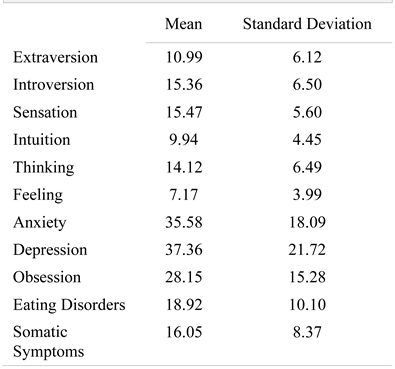 |
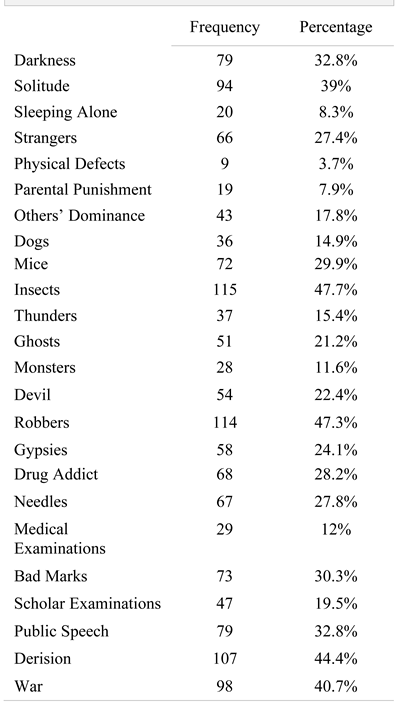 |
 |
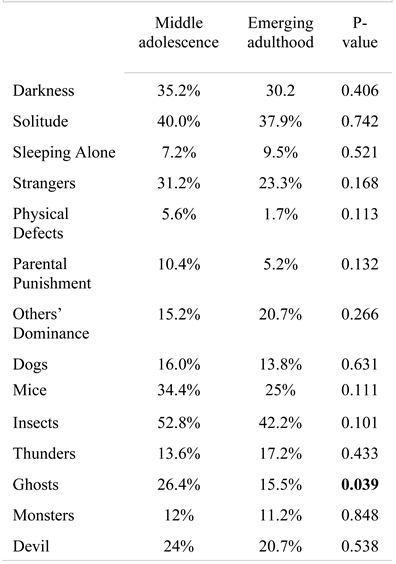 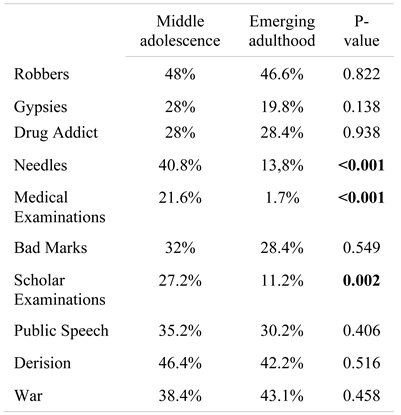 |
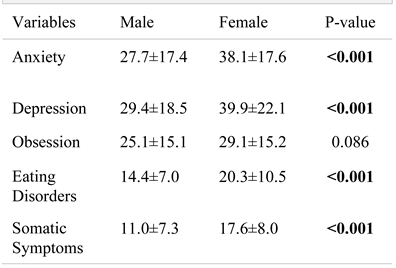 |
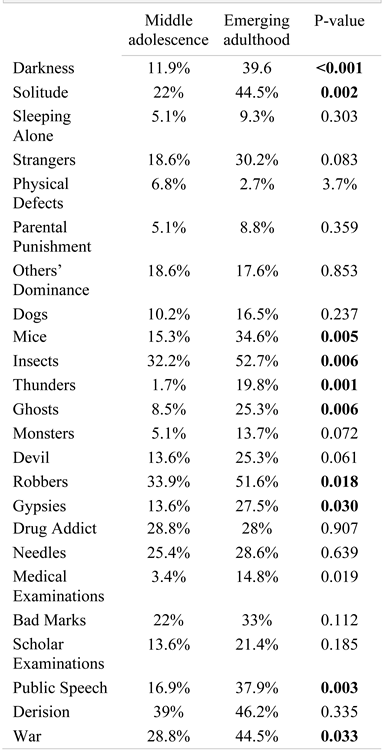 |
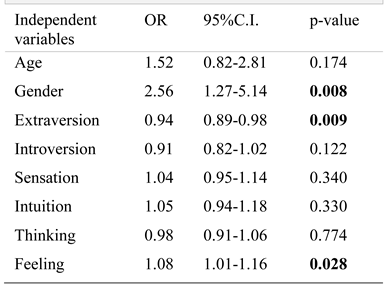 |
 |
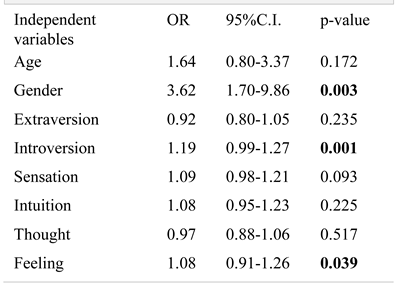 |
© 2019 by the authors. 2019 Salvatore Settineri, Emanuele Maria Merlo, Angela Alibrandi, Federica Sicari, Irene Pagano Dritto, Fiorella Strangis, Fabio Frisone.
Share and Cite
Settineri, S.; Merlo, E.M.; Alibrandi, A.; Sicari, F.; Dritto, I.P.; Strangis, F.; Frisone, F. Personality and Phobias in Adolescence: Age and Gender in Psychopathological Expressions. J. Mind Med. Sci. 2019, 6, 304-310. https://doi.org/10.22543/7674.62.P304310
Settineri S, Merlo EM, Alibrandi A, Sicari F, Dritto IP, Strangis F, Frisone F. Personality and Phobias in Adolescence: Age and Gender in Psychopathological Expressions. Journal of Mind and Medical Sciences. 2019; 6(2):304-310. https://doi.org/10.22543/7674.62.P304310
Chicago/Turabian StyleSettineri, Salvatore, Emanuele Maria Merlo, Angela Alibrandi, Federica Sicari, Irene Pagano Dritto, Fiorella Strangis, and Fabio Frisone. 2019. "Personality and Phobias in Adolescence: Age and Gender in Psychopathological Expressions" Journal of Mind and Medical Sciences 6, no. 2: 304-310. https://doi.org/10.22543/7674.62.P304310
APA StyleSettineri, S., Merlo, E. M., Alibrandi, A., Sicari, F., Dritto, I. P., Strangis, F., & Frisone, F. (2019). Personality and Phobias in Adolescence: Age and Gender in Psychopathological Expressions. Journal of Mind and Medical Sciences, 6(2), 304-310. https://doi.org/10.22543/7674.62.P304310



